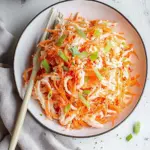These Korean Fried Chicken Bao Buns are the ultimate combination of spicy, sweet, and crispy wrapped inside a soft, fluffy bun. Perfect for dinner parties or a creative weeknight meal, they bring together bold Korean flavors with the satisfying texture of perfectly fried chicken.
Whether you’re a fan of street food or looking to try something new in your home kitchen, these bao buns are the answer. Topped with crunchy cabbage, quick pickles, and fresh herbs, they offer the perfect contrast of textures and taste in every bite. Serve with a cold drink and watch them disappear fast.
Full Recipe
Ingredients:
For the Chicken Marinade:
-
500g boneless chicken thighs, cut into bite-sized pieces
-
1 tbsp soy sauce
-
1 tbsp rice wine (mirin or sake)
-
1 tsp garlic, minced
-
1 tsp ginger, minced
-
Salt and pepper to taste
For the Chicken Coating:
-
1/2 cup cornstarch
-
1/2 cup all-purpose flour
-
Oil, for deep frying
For the Gochujang Sauce:
-
2 tbsp gochujang (Korean chili paste)
-
1 tbsp soy sauce
-
1 tbsp honey
-
1 tbsp brown sugar
-
1 tbsp rice vinegar
-
1 tsp sesame oil
-
1 garlic clove, minced
For the Bao Buns:
-
8 store-bought or homemade bao buns
-
1/4 cup pickled cucumbers
-
1/4 cup shredded purple cabbage
-
1 tbsp toasted sesame seeds
-
Fresh cilantro leaves for garnish
Directions:
-
In a bowl, combine the chicken pieces with soy sauce, rice wine, garlic, ginger, salt, and pepper. Marinate for at least 30 minutes.
-
While the chicken is marinating, prepare the sauce by combining gochujang, soy sauce, honey, brown sugar, rice vinegar, sesame oil, and garlic in a small saucepan. Simmer over low heat for 3–5 minutes until thickened. Set aside.
-
Heat oil in a deep pan to 350°F (175°C).
-
Mix cornstarch and flour in a shallow bowl. Dredge each piece of marinated chicken in the dry mix, coating well.
-
Fry the chicken in batches for 4–5 minutes until golden and crispy. Drain on paper towels.
-
Toss the fried chicken pieces in the gochujang sauce until fully coated.
-
Steam the bao buns according to package instructions or until soft and fluffy.
-
Assemble each bao with a few pieces of saucy fried chicken, pickled cucumbers, shredded cabbage, sesame seeds, and cilantro. Serve hot.
Prep Time: 40 minutes | Cooking Time: 20 minutes | Total Time: 60 minutes
Kcal: 430 kcal | Servings: 4 servings
The Origins of Korean Fried Chicken Bao
Korean Fried Chicken Bao is a remarkable fusion dish that merges Korean and Chinese culinary traditions into one satisfying bite. At its heart, this dish celebrates the crispy, spicy, and umami-rich nature of Korean fried chicken, paired beautifully with soft, fluffy Chinese-style steamed bao buns. While Korean fried chicken itself is a relatively modern invention—emerging prominently in the 1970s and gaining international popularity in the 2000s—its pairing with bao is a trend that stems from the wave of Asian-fusion cuisine flourishing in the West.
In Korea, fried chicken is often enjoyed as “chimaek”, a combination of chicken and beer, and is known for its paper-thin, crackly skin thanks to a double-frying method. Incorporating this into a bao bun provides a creative platform to enjoy these bold flavors in a handheld, street food-inspired format that feels modern yet rooted in tradition.
The Global Rise of Fusion Cuisine
Fusion cuisine allows for cultural exchange and experimentation, leading to new, beloved dishes like Korean Fried Chicken Bao. The dish appeals to adventurous eaters who appreciate intense flavors, playful textures, and bold presentation. As culinary boundaries continue to blur across countries and continents, dishes like this reflect the modern kitchen’s endless creativity and adaptability.
In particular, bao buns—once niche—have become mainstream due to their versatility. They’re soft, slightly sweet, and designed to hold savory fillings. Pairing them with Korean fried chicken, coated in sticky gochujang sauce, taps into both the nostalgic comfort of fried food and the contemporary love for globally inspired street eats.
Why Gochujang is a Game-Changer
The real star of the show in Korean Fried Chicken Bao is the gochujang glaze. Gochujang is a fermented Korean chili paste made from red chili powder, glutinous rice, fermented soybeans, and salt. It brings a unique blend of sweet, savory, spicy, and umami to every dish it touches.
Unlike many Western hot sauces that prioritize heat, gochujang offers a depth of flavor that enhances the dish without overwhelming it. It clings perfectly to fried chicken, coating each piece with a sticky sheen that locks in flavor and moisture. When added to bao, it balances out the softness of the bun and adds a punch that makes the dish utterly addictive.
Textural Harmony in Every Bite
One of the most satisfying elements of Korean Fried Chicken Bao is its combination of textures. The bao bun is pillowy and soft, creating a neutral backdrop that lets the other components shine. The chicken brings crunch and richness, thanks to its double-fried coating and juicy interior. Meanwhile, garnishes like pickled cucumbers, shredded cabbage, sesame seeds, and fresh cilantro introduce brightness, acidity, and freshness.
These contrasting textures make each bite interesting and balanced. The crunch of the chicken against the soft bao, the acidity from the pickles cutting through the richness, and the herbs bringing an aromatic finish all work together to elevate the dish.
How to Customize the Dish to Your Taste
One of the great things about this recipe is its flexibility. While it’s delicious as written, it also invites customization depending on your dietary needs or flavor preferences. For example:
-
Vegetarian version: Use tofu or cauliflower in place of chicken and coat with the same gochujang glaze.
-
Gluten-free adaptation: Use gluten-free flour blends and check your sauces to ensure they’re gluten-free.
-
Add-ons: Consider adding crushed peanuts for crunch, a squeeze of lime for brightness, or even kimchi for extra tang and spice.
-
Heat level: You can adjust the spice by using more or less gochujang, or by adding chili flakes or hot sauce to the glaze.
Whether you’re cooking for a group or just making a weeknight treat for yourself, this dish can adapt to what you have in your pantry or what you’re craving that day.
Perfect Occasions to Serve Korean Fried Chicken Bao
This dish isn’t just for a quiet night at home—it’s also perfect for hosting. The bao buns can be assembled as a DIY station, allowing guests to create their own combinations with different toppings. They also make fantastic appetizers for parties, served mini-sized for easier handling.
Think of occasions like game day gatherings, birthdays, casual dinner parties, or even food truck-style outdoor events. Korean Fried Chicken Bao is eye-catching, fun to eat, and universally appealing. You can scale up the recipe for a crowd, and even prepare many components in advance for easy assembly.
Healthier Twists Without Losing Flavor
If you’re watching your calorie intake or aiming for a healthier option, there are still plenty of ways to enjoy this dish. Instead of deep frying the chicken, try air frying or baking it with a crispy coating. You’ll retain much of the crunch and flavor without the extra oil.
Swapping out regular bao buns for whole wheat or low-carb buns can also lighten the dish. Incorporating more fresh veggies like lettuce, julienned carrots, or sprouts adds volume and nutrients without sacrificing taste.
Gochujang itself, while flavorful, can be high in sodium, so balancing it with low-sodium soy sauce and controlling the quantity helps make the glaze healthier without losing that punchy character.
Why It’s a Crowd Favorite
There’s a reason Korean Fried Chicken Bao is trending not only in restaurants but also in home kitchens and social media food circles. It checks all the boxes:
-
Visually stunning with its bright colors and glossy sauce
-
Flavor-packed with spicy, sweet, and savory notes
-
Texturally diverse, combining crispy, soft, and crunchy in each bite
-
Easily shareable, making it ideal for gatherings and food styling
People love food that feels indulgent but is also unique and creative. This dish delivers all of that and more.
Tips for First-Time Bao Makers
If you’re making bao buns from scratch, it may seem intimidating at first, but with a bit of practice, it’s quite manageable. Start by mastering the dough texture—it should be soft but not sticky. The key is proper steaming: steam buns over boiling water in a bamboo steamer lined with parchment paper. Be patient and don’t lift the lid too early, as that can cause buns to deflate.
However, for simplicity, store-bought frozen bao buns work great and can often be found in the frozen aisle of Asian supermarkets. Steaming them directly from frozen makes them fluffy and warm in minutes.
Cultural Significance of Ingredients
The use of bao in Chinese cuisine dates back centuries and is a symbol of comfort and nourishment. In Korean cuisine, chicken plays a central role in communal eating, and gochujang is one of its most essential condiments—found in everything from bibimbap to tteokbokki.
Bringing these elements together pays homage to the depth and richness of both cultures. It’s a modern tribute to traditional flavors while creating something entirely new that resonates with global palates.
Conclusion
Korean Fried Chicken Bao isn’t just a dish—it’s an experience. It represents the joy of cooking across cultures, the fun of experimenting with bold flavors, and the satisfaction of creating something that’s both comforting and exciting. Whether you’re a seasoned foodie or a curious beginner, this fusion masterpiece is sure to become a staple in your kitchen.
From its crispy golden chicken to its spicy-sweet glaze and its delicate steamed bun, every component works in harmony. More than just a recipe, it’s a celebration of what happens when tradition meets innovation on a plate. Try it once, and you’ll find yourself craving its addictive combo of crunch, heat, and pillowy softness again and again.






